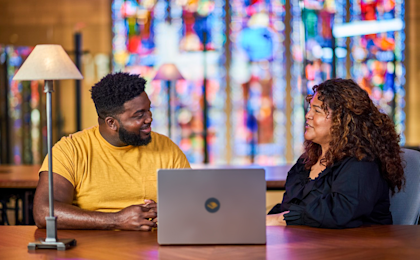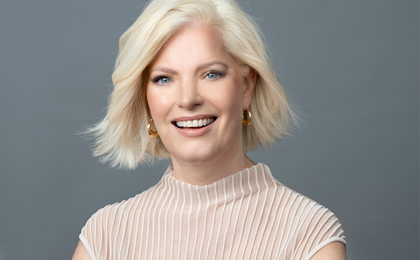Our Sound Designers Build Whole Worlds, One Audio Effect at a Time

When Audible producer Thomas Mann was listening to our Original comedy Space 1969, there was a moment when the sound design was so convincing, he “had to open a window and check if it was really raining.” This is the kind of reaction our studio teams want to provoke when they mix titles in immersive 3D audio. It “helps bring the listener deeper into the story almost subconsciously,” says Audible’s sound designer for Space 1969 Darren Vermaas. “It's a way to feel like you're sitting in this world, watching the characters interact.”
Audible sound designers are obsessed with immersing listeners in new worlds, which they do by choosing and artfully applying sound effects and then mixing the finished product to create an overall experience or emotional response. “I was always interested in how sound affected emotions,” says Alex Trajano, who has been a sound designer at Audible since 2016. “I’d often watch a movie with the screen turned off just to hear how they placed the sound effects and what they made me feel.”
The best way for designers to achieve those truly emotive effects is to make them on their own. This was an idea Vermaas pitched to his Audible Studios managers shortly after being hired in 2011. “Sometimes you need something very specific, and it’s easier to just record your own,” he explains. The team jumped at the chance to create in-house effects, or Foley, as they are called, after one of the early film sound-effect artists Jack Foley. They started recording sounds like their cars starting and their steps on paver stones. This organic approach to bespoke effects has allowed designers to bring more of their imagination to Audible productions.
Sound designers have also been inspired by 3D sound technology to craft ultra-immersive experiences. Working with Dolby experts, the team has set up and tuned rooms at Audible Studio locations in the US and UK that are expressly for use with Dolby’s Atmos 3D mixing system. In this paradigm, designers first record sounds for a production, or collect them from Audible’s huge library of effects. Then the Atmos system takes those sounds, coming out of an array of 360-degree placed speakers, and encodes them for the right and left headphones. “You can mix it so the sound feels like it’s moving in a circle around you,” explains Trajano, “or add height so sound moves up and down. We even use plug-ins that can make you sound like you’re talking upstairs or in the other room.”
As Audible’s offerings of multicast drama and comedies, sci-fi thrillers, and theatrical productions continue to expand, the team has been identifying titles that work best in the 3D format. These include NYT-bestselling multicast dramas like The Sandman, which is ideal for a cinematic listening experience, and the podcast Pillow Talk, which uses heavy doses of ASMR, full of whispers, light scratching, and tapping. Audible Theater productions are also perfect for 3D, which recreates the immersive experience of being right there in the theater with the performers.
For those productions, Vermaas and Trajano have recorded hospital noises and busy London streets, which are then mixed to move around the listener in space. But it’s one thing to add sound after the fact, and another to write, direct, and perform a production with sound design already in mind. That’s now a regular thing for our Originals, including works commissioned through Audible’s Emerging Playwrights Fund. The sound designers for those productions start working with writers and directors from the get-go. “The earlier we get in the room, the better,” says Vermaas. He and Trajano attend pre-production meetings with creators to work out opportunities for sound to make the most impact. “People are so used to sound effects being aided by a visual, but if you don’t have that you’re really reliant on the writing and acting and sound design working together to make that believable and enjoyable.”
Sometimes, sound designers find themselves giving direction in order to achieve the realistic effect of action or conversations moving around the listener in space—especially when the recording is happening virtually, as it has more and more since the start of the pandemic. For the Audible Theater production Vanishing Negative, Vermaas was working with Tony Award-winning actress Betty Buckley, who was recording from a studio in Texas, and thinking about ways to simulate the sounds of a 360-degree fight. To his surprise, Buckley dove right in, throwing herself around her booth and rolling around on the floor to achieve the effect.
But even as sound design technologies evolve, one thing never changes: designers still love creating their own Foley. For Audible Theater’s Evil Eye, which won a 2020 Audie Award for Best Original Work, Trajano followed his girlfriend around the kitchen as she cooked—and leaned into his musical background to score the production, which he has been doing more often. For the middle-grade adventure, Riley Mack and the Other Known Troublemakers, Vermaas and fellow sound designer Pat Hynes recorded dogs barking at a local shelter. And for the retro-futuristic Space 1969, penned by Bill Oakley (The Simpsons, Portlandia), Vermaas created the familiar “bionic” sound from classic sci-fi by bending a metal ruler and distorting the audio. Part of the art of sound design, he says, is restraint. “Bill's writing—and the actors' execution—is so funny that I was still laughing at lines after months of working on the project. I didn't want to step on that writing and humor with design. I think where we landed really complements the story.”
Looking back over Audible’s last decade-plus in sound design, Vermaas says, “I’m really proud of build[ing] these worlds from the ground up.” Trajano adds that he’s grateful sound designers are able to have this much fun. “I explain to people what I do and they can’t believe it’s a job.”



